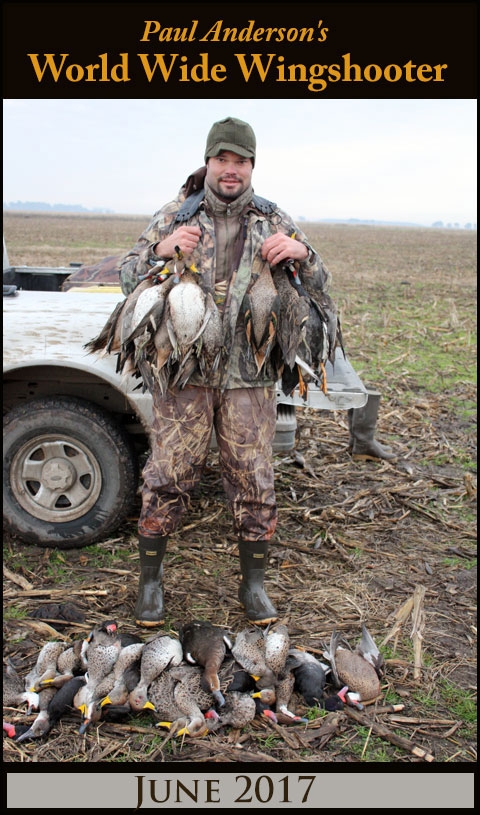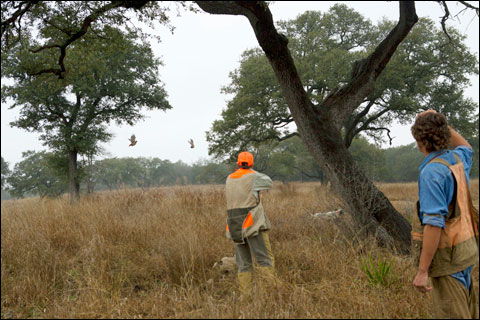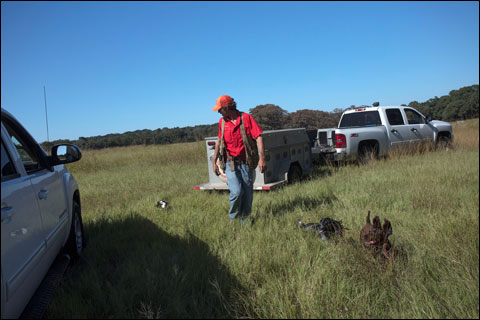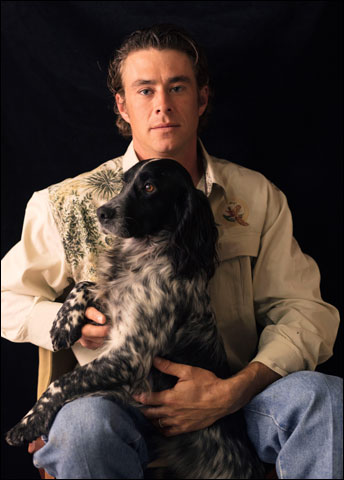Meet Eric Harrison, the 2017 Orvis Endorsed Wingshooting Guide of the Year

I’m extremely proud of my good buddy, Eric Harrison of Joshua Creek Ranch, who received the 2017 Orvis Endorsed Wingshooting Guide of the Year. Eric and I have been friends for many years, and I know him as a great guide and father. Many of Shotgun Life’s readers have hunted with a guide like Eric or Eric himself at some point. I thought it would be helpful to sit down with him for a quick Q&A to discover what it takes to be a winning wingshooting guide and how you can benefit from hunting with someone like him.
We’ll start with a quick bio of Eric and then jump into our conversation. He grew up in Kentucky along the Ohio River, where Eric shared a passion for hunting with his father, who took him hunting as a young boy. He graduated from Southeastern Illinois College in 2002 with a degree in Game Preserve Management then moved to Texas to pursue a career as a hunting guide. In 2007 Eric started working at Joshua Creek Ranch. He’s a Texan at heart and embodies the spirit of “Texas Hospitality.”

Award-winning wingshooting guide Eric Harrison of Joshua Creek Ranch.
Who is Eric Harrison?
I’m a lucky individual who chose a job he loves, and therefore doesn’t have to work a day of his life. Growing up in the outdoors and then able to make a living from it is a dream come true. I’m a proud father, loving husband and God-fearing Republican.
How long have you been a guide? How’d did you get into guiding?
My father started taking me hunting with him when I was four years old and it’s been game-on ever since. Once I started attending middle school Dad told me to make a choice between sports and hunting due to not enough time for both. I didn’t choose sports thank God − a penguin could probably out-dribble me down a basketball court. I started hunting for a paycheck a little over a decade ago and have loved every minute of it. My favorite part to being a guide is all the hunters I get to meet and share my dogs with.
Why do you think you won this year’s Orvis Endorsed Wingshooting Guide of the Year?
I feel I won for many reasons. First, it’s easy to put on a great show when working at the world’s best hunting lodge, Joshua Creek Ranch. Second, I have the confidence to say my hunting-dog team on their worst day could out-hunt the average dog on their best day. And last would be my love for the sport. I not only have a loving family that raised me, that family has grown into a ranch, my dogs, my hunters and it’s become a great strength.
Who are people that have helped you get to where you are now? Who does Eric look up to in wingshooting or life?
My mom and dad get the credit for putting me on the path, and getting me birdie at a young age. My uncle Mike inspired me to train dogs. And without Bruce Herring, my professor at Southeastern Illinois, I wouldn’t be where I am today. He helped me get my degree in a very unique program that touches on all aspects within the hunting industry. Last, but not least, my hat goes off to Joe and Ann Kercheville, who own Joshua Creek Ranch. The Kercheville family took me under their wing 11 years ago, and like a started dog they finished me. Thank you Joe, I appreciate all that you have taught me.
You’re one of wingshooting’s best ambassadors. How many new shooters do you think you guide in a year?

Pheasants taken at Joshua Creek Ranch under the guidance of Eric Harrison.
New hunters and old hunters are all the same, just a soul trying to reconnect with Mother Nature. At Joshua Creek we open our doors to any person wanting to share the experiences here. I hunt in the double digits every year with first-time hunters. In some respects a new hunter hasn’t acquired any bad habits and is easy to train more than a mature hunter. New or old my only concern is that the hunter has a safe and enjoyable hunt.
Do you have any advice for new wingshooters? Advice for people wanting to expose others to the sport?
From one avid wingshooter to another it should be a goal to hunt more and more each year and to experience different ways to hunt. Shooting pheasants behind pointers is great but adding three cockers to the mix is better. Harvesting 15 doves is fun but shooting 1,500 dove in Argentina is mind blowing. Never stop moving forward in your hunting experience. If a hunter shoots birds five times in a year, that hunter should make it a goal to shoot birds six times the following. I’ve been hunting my entire life and it took me 33 years to find out that my favorite bird to shoot is a driven pheasant in England, but my new goal is to shoot grouse in Scotland.
What in your view can we, as sportsmen and women, do to better promote the outdoors to non-hunters?
The best way to promote hunting is exposing it to our youth. My dad spent every weekend teaching me the outdoors and a lot of kids don’t have that. If hunters could stop a kid from playing on the computer and take the kid outside for an adventure it would change that kid’s life for the good. I challenge all hunters with the 5-to-1 deal. For every five hunts you go on you take a youth hunter on the sixth.
What’s your favorite breed of bird dog and why?
My favorite breed of bird dog is the kind that hunts, but I love English dog lines. Setters and cockers have a great temperament, eager to please, always ready to hunt as well as great family companions. Sonto was the name of my first Joshua Creek bird dog and my best dog now is a long-haired black and white setter named Sonto. He can work a field like a conductor leading an orchestra.
If you could hunt with anyone, dead or alive, who would it be?
If I could hunt with anyone in the history of hunting it would be good old Teddy Roosevelt in Africa. That man knew how to hunt. Second would be my great grandpa, Pascal. He lived in the Tennessee mountains and made his money by guiding bird hunts, taking folks fly fishing and moonshining.

Eric Harrison and his dogs ready for a wingshooting hunt at Joshua Creek Ranch.
When you meet a group for the first time, what are some telltale signs you might look for? Is there a “Don’t be that person”?
Here are three tips for wingshooters. First, don’t show up to a quail hunt with a 12 gauge, that’s way too much gun for such a small bird. With experience you’ll find shot placement outweighs firepower. Two, don’t wear new boots; they will only cause blisters. And three, don’t wear camo. Dogs hold birds on point so no need to hide from the bird. Wingshooting is a gentleman’s sport, so pick up an Orvis catalog and look the part. The same goes for the guide you’re hunting with. If your guide shows up with new boots, new hunting vest and a cheesy grin then march back into the pro-shop and ask for an experienced guide.
Where else have you hunted besides Joshua Creek Ranch?
I have been on hunts from Alaska down to the Mexican border. Shooting dove in Argentina was a blast but that didn’t touch shooting pheasant in England. I’m 33 and very excited about what’s next; teaching my son is going to be special.
Tells us about your worst hunt?
Good hunts come and go but my worst hunts always originate from a lack of communication. Either between my dogs or my hunters, and it can spiral out of hand. My dogs are well-trained, but with the number of hunts I run it’s inevitable that they’ll have a bad day. Communication with my hunting clients is important. For example you don’t want them walking past birds. It’s a delicate balance between doing what the hunter wants and guiding a good hunt.

Eric Harrison with his dog Gucci.
Tell us about your best/favorite hunt?
On the other hand my favorite hunt happens all the time and is easy to duplicate. Get a group of shooters with positive attitudes who can shoot, and have them follow me around a pasture as I work my dogs. Then when the dogs start going on points left and right we flank them. The best feeling in the world is when all of the hunters are focused on the sound of a cocker running into the tall grass flushing a covey.
If you were to hunt one bird and one bird only for the rest of your life which would it be?
Quail behind setters.
We’ve talked many times about your theory of the “team” aspect of upland hunting, I find your explanation very insightful. Can you explain Eric Harrison’s team approach to guiding a bird hunt?
The guide is the leader. Dogs and hunters should always follow instructions of the guide. My number-one goal on a hunt is to keep my dogs and hunters safe. I don’t wake up in the morning with the expectation for a mediocre hunt, and it irritates me to not come in with the most birds.
Dogs are a tool, a key component to finding the birds. It takes the right tool for the job and many hunts differ, so be sure to know your dog and to have the right tool for the job. Without a good dog the hunt has already failed.
The hunter is the talent and should have many different skills in order to be good. It must be understood that their position is to follow the guide, but recognize when it’s their time to lead. They should study their skills and understand the mechanics of shotgun shooting and shot placement – to foresee shot obstacles and work as a team so when a bird rises someone in the party will have a shot presentation. Knowing how a bird dog should properly work so one can read a dog’s body like a book when he says, get ready I’m birdie. And remember that they are the reason the team came to play.
There is a growing trend in the hunting industry to market the fitness aspects of hunting, with many guides and T.V. hosts claiming to be athletes. Do you consider yourself a hunting athlete?
As a kid I would tell my city-slicker friends that hunting was a sport and they teased asking me where are my trophies. Hunting is a sport with trophies and has athletes like any other sport. I hunt because I’m driven to it. I train with my team every season and we give it our all. But hunting is way more than a sport to me. It’s a family tradition I want to pass down to my son. It started as a tool of survival and has evolved into my family and life. I love the ranch I work for and I love my family and consider it all my hunting team and as part of my life.
Where do you see yourself in 10 years?
My goals for the coming years are to keep training and perfecting my skills. I want to be healthy and happy with a strong family. It turns out that I’m a very competitive person and I don’t like to be last. Joshua Creek Ranch has been a great family to me and I will always be there for them. I did go to school to become a hunting ranch manager and feel I’m following the path and right leaders to be a great one.
What’s it like to guide at Joshua Creek Ranch?
It’s just as much fun to guide at Joshua Creek as it is to hunt. The property is 1,200 acres of perfect bird-hunting habitat with miles of moving water and high hills. It’s fun to have such an incredible office. We have divided the ranch into 12 different hunting pastures and each guide is assigned a different pasture each hunt, leaving excitement for what’s to come. The hunts are always changing, birds are always moving, and I always have hunters. What more could a guide ask for?
What’s a hunt like at Joshua Creek Ranch?
Hunting at Joshua Creek Ranch is a bird hunter’s dream come true. Great dogs, great guides, lodging and meals, with a lot of hard work and dedication that keeps our hunters coming back. Average hunts are three hours long. Hunters go through three boxes of shells, so that’s 75 presented shots at different flying birds that were worked and pointed. Sounds like a pointing dogs dream come true too.
I highly recommend hunting with Eric. He’s seen more birds shot in his young life than most of us ever will. If you’re interested in hunting at Joshua Creek Ranch, feel free to give me a call or send an email and I’d be happy to set it up for you. They offer everything from driven pheasants to unbelievable walk up hunts.
Paul Anderson is Vice President of Detail Company Adventures at http://detailcompany.com. Based in Houston, Texas, Detail Company Adventures has been offering high-quality wingshooting, fishing and big game hunts in South America, Europe and America for more than 25 years. If you have any questions or need some advice feel free to contact Paul at paul@detailcompany.com or (800)292-2213.

If you have any questions or need some advice, please contact me at paul@detailcompany.com or (800)292-2213.


Comments